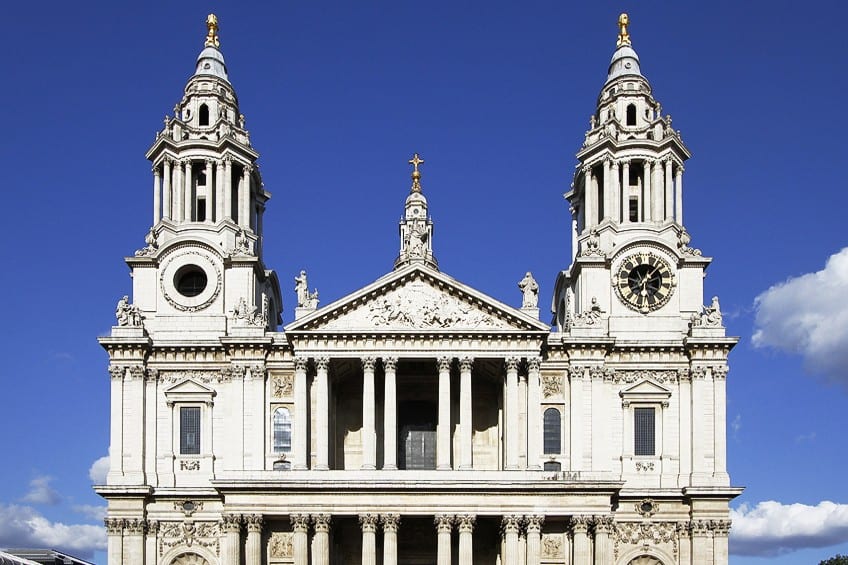St Paul’s Cathedral in London – The Historic London Cathedral
St Paul’s Cathedral in London is one of the most famous cathedrals in the United Kingdom, and so it should be worth a bit of an examination. We are going to discuss the architectural characteristics, architect, and history of this London cathedral over the course of this article. Stick around and keep reading if you want to learn more about St Paul’s Cathedral in London!
A Look at St Paul’s Cathedral in London
| Architect | Christopher Wren (1632 – 1723) |
| Date Constructed | 1675 – 1711 |
| Function | Cathedral |
| Location | London, United Kingdom |
It may be a bit redundant to ask this question, but where is the St Paul’s Cathedral located? Well, this church can be found within London in the United Kingdom. This church is a famous Anglican church in the city, and it is actually the mother church of the Diocese of London.
This means that it is, essentially, the most important Anglican church within London as it is the central cathedral of the Church of England within the region.
St Paul’s Cathedral in London is, as the name suggests, dedicated to Saint Paul the Apostle, one of the most foundational figures in the Christian faith in general. The earliest origins of this particular cathedral date all the way back to 60 CE. This means that the earliest days of this church were nearly 2000 years ago at the time of writing. Give it a few more decades and it’ll be two millennia.
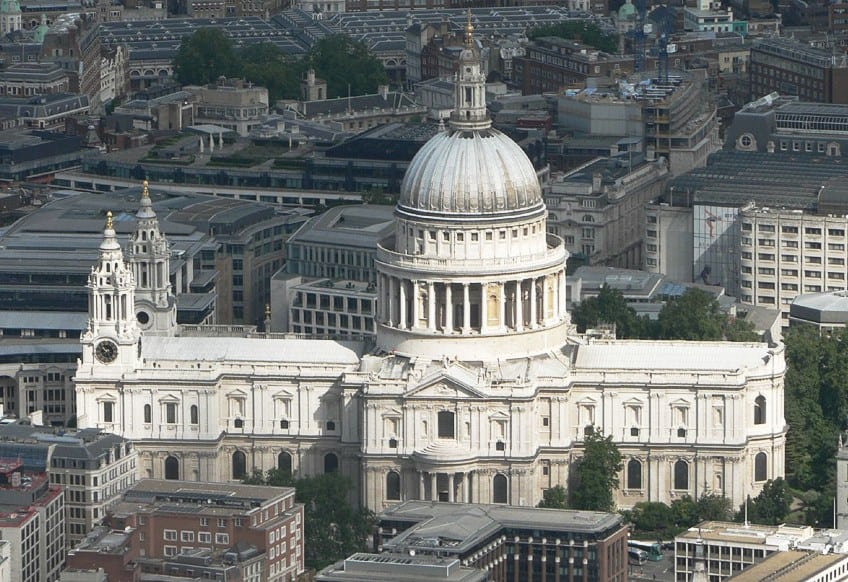
This church has stood as the central London cathedral for several hundred years, and it isn’t likely to end any time soon. In addition, this church is possibly the most famous cathedral designed by Christopher Wren, the famed English architect who aided in the reconstruction of the city after the Great Fire of London in 1666. Ever since its construction in the wake of that devastating fire, it has served as one of the most important sites in London.
It was also a prominent part of the skyline for centuries as it was the tallest building around, but skyscrapers somewhat took away the majestic height of cathedrals when they were developed in the 20th century.
St Paul’s Cathedral in London has also become a symbol of London. The image of it has been used in promotional materials for decades, and it has served as a central landmark within the most famous English city. In addition, it is still open as an actual church, but you can also visit the building as a tourist and get a tour (which brings in a significant amount of money, as will be discussed below).
The Architecture of St Paul’s Cathedral in London
St Paul’s Cathedral in London is not the first church that was constructed in that particular spot, but it is the most famous iteration of the church. This version was designed after the Great Fire of London of 1666 and the principal architect behind it was Christopher Wren, who adopted an English Baroque style when he designed the structure that would likely remain his most significant claim to fame.
The architectural style that was adopted was Baroque in nature, but it was far more restrained than the kind of Baroque structures that were dotted around Europe during this period.
Baroque architecture is known for its highly ornate style that would eventually become more and more opulent to the point where it embraced a further style known as Rococo. Rococo architecture essentially required that every wall was plastered with decorative elements, and it can be an immensely overwhelming sight. So, it was probably a good thing that Wren decided to design a more restrained form of it.
Christopher Wren’s Style for St Paul’s Cathedral in London
The general idea behind the architectural style of this famous London cathedral can be found in Wren’s decision to blend a Baroque style with a more sensible Palladian architectural design that embraced a cleaner, more Classical architectural look. However, it did also combine aspects taken from Roman Baroque structures and the buildings of Inigo Jones and François Mansart. So, he was inspired by various architectural avenues when he decided to produce his most famous building.
The structure’s layout led to it being both an immensely tall and a rather long structure. It stands at 111 m (or 365 ft) tall and stretches 158 m (or 518 ft) in length.
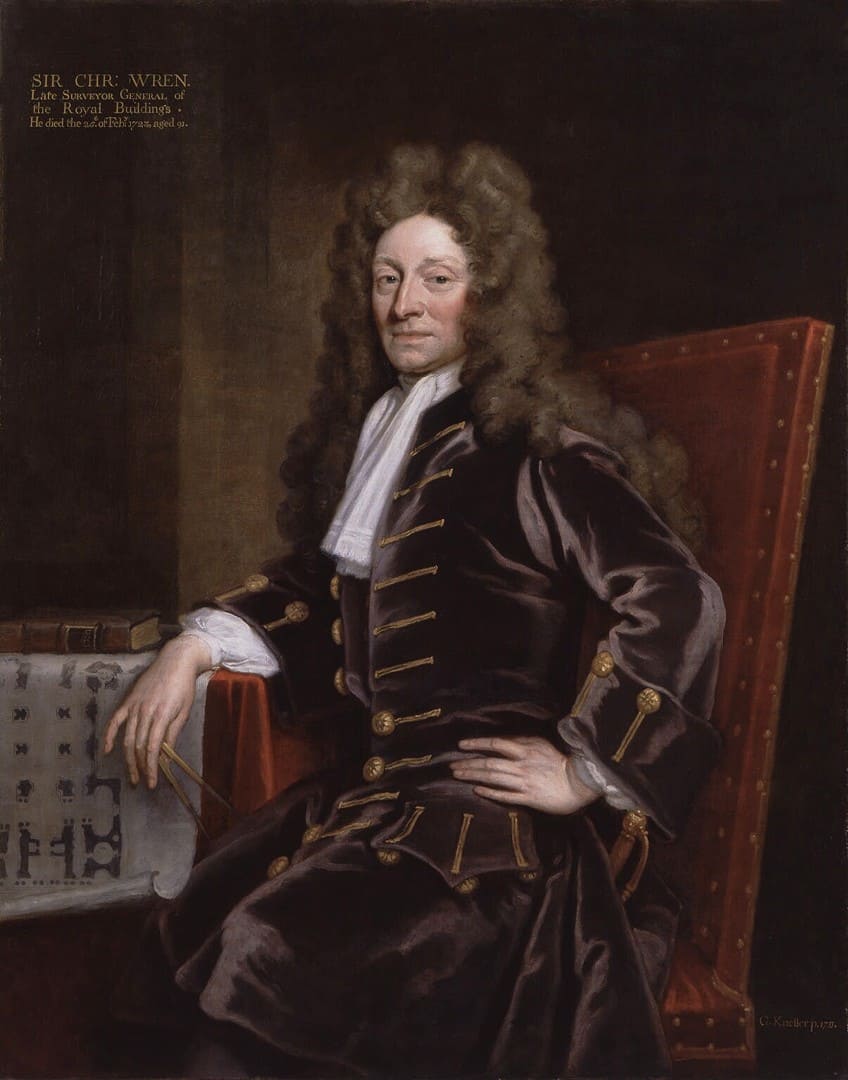
It’s also a comparatively slim structure, at only 75 m (or 246 f) in width between the transepts. This means that St Paul’s Cathedral in London is also a rather peculiar structure as many other cathedrals would have been far wider with the length that it possesses. Regardless of this, the overall height of the building made it the tallest structure in London from its construction all the way until 1963. It was only surpassed in the second half of the 20th century. This building withstood the test of time far longer than most, and it’s even impressive in size by today’s standards. For instance, it is the second-largest such church in the United Kingdom. The only church that is larger is Liverpool Cathedral. So, it is still one of the largest in the region.
The Inspirations Behind St. Paul’s Cathedral in London
When Wren decided to design this building, he did so with some important inspirations behind him, and when it came to the dome, which is one of the most prominent features in many cathedrals, he needed to take inspiration from somewhere prominent.
So, he took his inspiration from the best place he could: the dome of St Peter’s Basilica in Rome (which had been designed by Michelangelo). He also drew inspiration from the Church of the Val-de-Grâce in Paris (which was designed by François Mansart).
He did not emulate these churches though. Instead, he only drew some inspiration from them. His dome would be a double-story dome that made use of two styles within it. So, the two levels of the dome are unique in their overall design. There is a colonnade structure that wraps around the drum of the dome and is juxtaposed against the second floor of the dome. The second level is instead designed around a balustraded balcony that uses rectangular windows and an array of pilasters to produce a dome base structure that was quite unlike anything else.
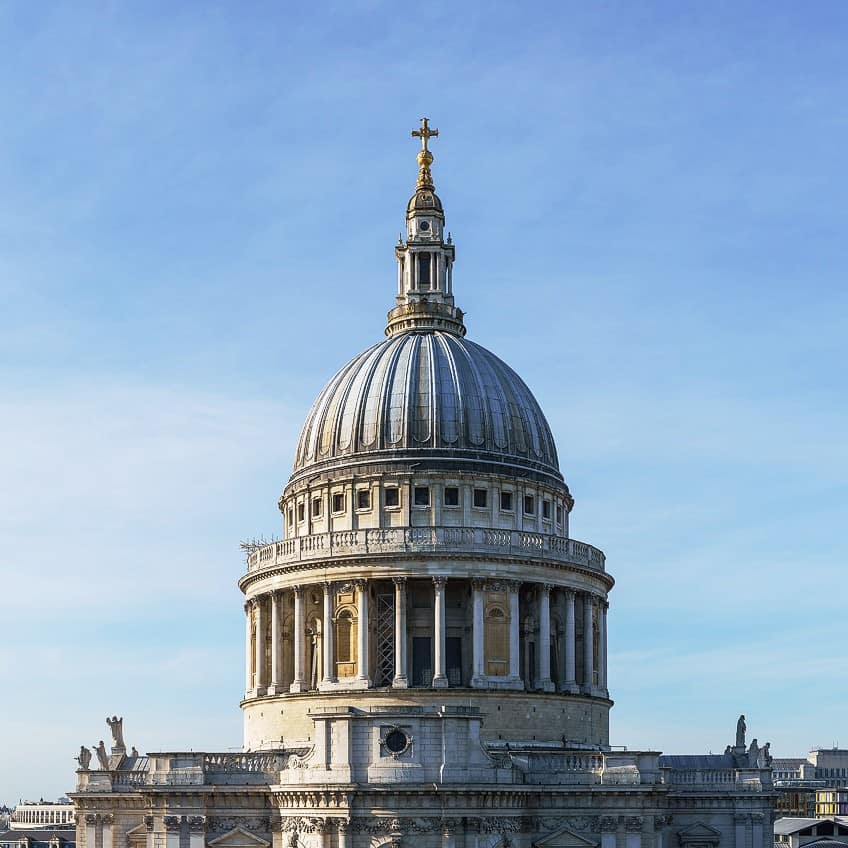
The very top of the dome, the lantern, also progresses through several stages as it rises high above the city skyline. The combination of the masonry used for the base and the golden top has led to this being one of the most stunning sights in the city, and one of the most famous cathedral domes in the world.
Other than the dome, St Paul’s Cathedral in London also makes use of tower structures that are even taller than the dome with a double-story design for the structure as a whole.
Although, there is a balustrade above the upper cornice that was added even though Wren didn’t want it there. Regardless of his feelings on the matter, it has become an integral aspect of St Paul’s Cathedral in London’s overall structure that contributed to this cathedral being one of the most famous in the United Kingdom.
The Architect of St Paul’s Cathedral in London
Christopher Wren served as the architect of this and many other London cathedrals. He is one of the most famous English architects to have ever lived, but he was not only an architect. He was also a polymath of sorts as he was interested in mathematics, physics, astronomy, and various other academic pursuits.
He then became a national icon because of the work that he did, and this is, for instance, reflected in the fact that he was even printed on the £50 British banknote from 1981 to 1994.
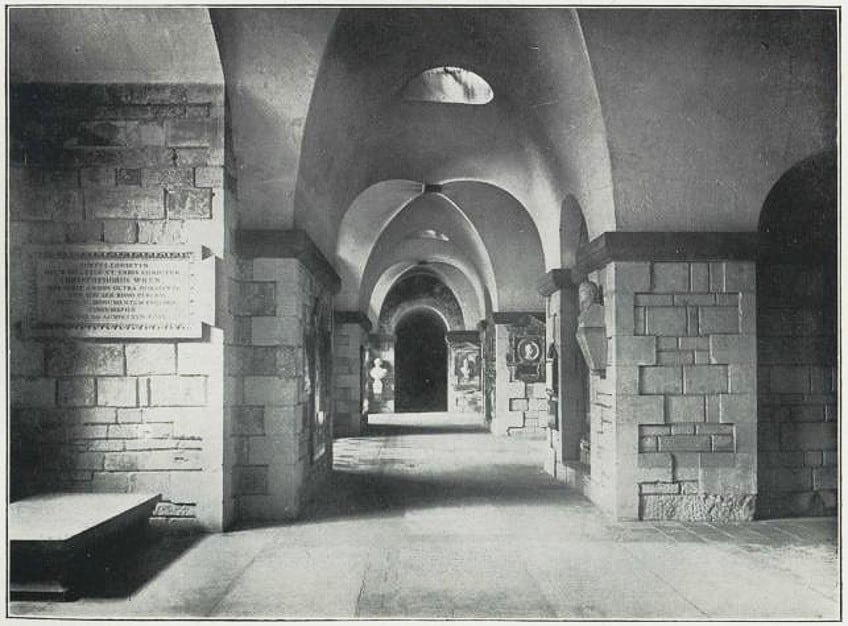
This perhaps demonstrates how much of an icon he has become in the British consciousness. He was most famous for his work after the Great Fire of London in 1666 when he designed many of the churches that needed to be rebuilt. He made use of the English Baroque style and was a major proponent of that style until his death. The Baroque style, in general, was typically highly ornate and made use of vivid imagery and is noted for its immense theatricality. So, this kind of style likely led to Wren becoming known for the surprising architectural delights that he produced, and while St Paul’s Cathedral in London is not the only church he designed, it is probably the most famous.
Famous Events Held at St Paul’s Cathedral in London
St Paul’s Cathedral in London has been the location for a number of historical events over the years. It was used for the funerals of several influential British figures, such as Lord Nelson, Winston Churchill, and Margaret Thatcher. It was also used for various jubilee ceremonies, such as the jubilees of both Queen Victoria and Queen Elizabeth II (and it was also used for the 80th and 90th birthday celebrations of the latter queen).
One of the most famous events that occurred in St Paul’s Cathedral in London was the wedding between Prince Charles and Lady Diana Spencer in 1981. Westminster Abbey is generally the location used for royal weddings, but this church allowed for more seating and so attendance could be higher than it would otherwise be.
These are only some of the prominent events that have taken place in this famous London cathedral. In the future, there will no doubt be even more such events because once a structure becomes known for hosting important events, that then transforms into a tradition. So, it may just be a tradition that St Paul’s Cathedral in London is the location for so many prominent events within the British Isles.
The History of St Paul’s Cathedral in London
St Paul’s Cathedral in London has a rather lengthy history, but much of that history is also, sadly, shrouded in mystery. Whenever a region has been occupied for a particularly long time, and this region has been occupied for an immensely long period, it loses some of its recorded history along the way. In the case of this particular London cathedral, the history of the building starts a very long time ago.
Before the Normans
Long before the modern St Paul’s Cathedral in London was built, there was, according to tradition, a Roman temple situated on Ludgate Hill. This is the location on which the modern church would eventually be constructed. This temple may have been there as early as 60 CE. However, things would eventually develop from there.
In 604 CE, King Aethelberht I decided to construct the first official Christian church on this site, and that church was dedicated to Saint Paul the Apostle.
So, the dedication to that particular saint existed long before the contemporary church. However, that church then burnt down, but it was quickly replaced. Then that church was destroyed by Vikings in 962 CE. So, there were a few issues along the way. But there was no need to worry because a new cathedral was constructed… and it then also burned down. This time it burned down in 1087. This was when the Normans finally came in and decided to do something a little bit different with the site of such an ancient religious patch of earth. So, they got to work on a new cathedral.
The Norman Church
The Norman version of this cathedral, known as Old St Paul’s, was completed in 1240. It was first constructed around a Romanesque style, but by the time the building had completed its construction, it incorporated Gothic elements too. So, this old version had something of a combination of architectural styles within its walls. This church would stand for a long time, but it was eventually enlarged, and this work started in 1256. It was completed by 1314, and it became one of the largest cathedrals at the time of its construction.
According to some archaeological findings, it may have been 178 m (or 585 ft) long with spires that reached 149 m (or 489 ft) in height. However, this structure would fall into disrepair.
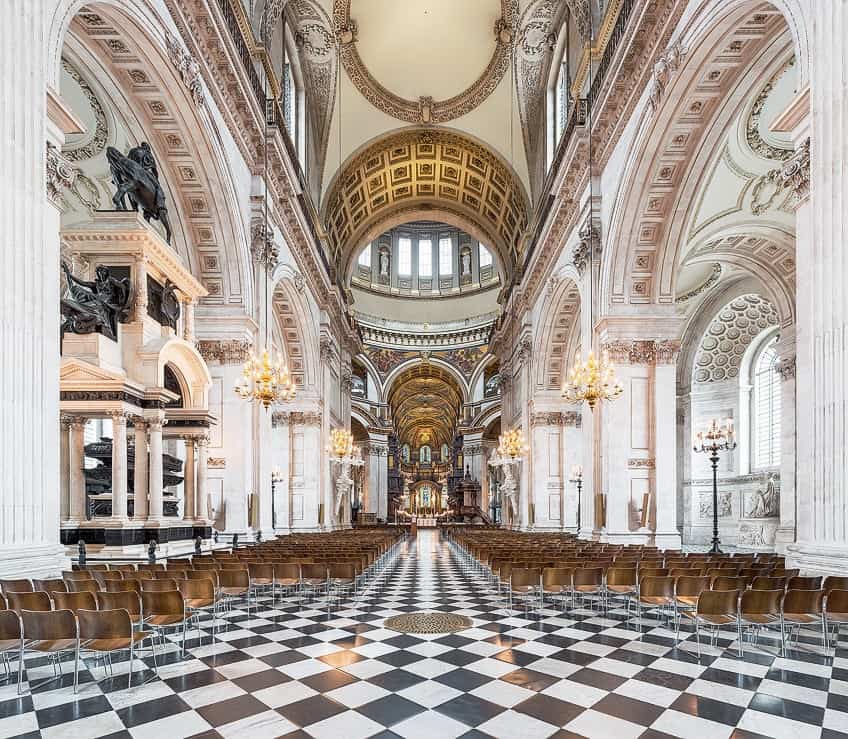
It was too expensive to maintain, and when it was maintained, it was usually done somewhat cheaply. Then the Great Fire of London of 1666 happened. The Old St Paul’s had practically crumbled away. It may have been possible to reconstruct it, but instead, they decided to develop an entirely new cathedral to replace the old one. This cathedral would adopt modern architectural styles (or modern for the time), and it would serve as a grand Anglican monument.
The Current Church
Everything got underway in 1669 when Christopher Wren was assigned his role as the St Paul’s Cathedral in London’s architect, and he developed a brand new church in the English Baroque style. This new church was funded through taxes, and it was also, interestingly, completed during Wren’s lifetime.
It isn’t very common that construction of this variety manages to accomplish something like that, but it did.
The new St Paul’s Cathedral in London was consecrated for religious use in 1697, but it was only officially completed in 1711 (on Christmas Day too). Once it was entirely unveiled, it received mixed reviews. Some adored it and others criticized it quite heavily. However, regardless of the criticism, it would remain one of the most enduring images of London.
The Challenges of the 20th and 21st Centuries
St Paul’s Cathedral in London has persisted as a church throughout its existence, but it has been subject to a few difficult points over the last hundred or so years. It was the target of two separate bombing incidents in 1913 and 1914 by members of the suffragette movement as the Church of England had been deemed complicit in the oppression of women (which is not an unfounded belief to have considering the policies of many religious organizations).
It then suffered two separate bomb strikes in the Second World War. There was one in 1940 and another in 1941. They did not manage to destroy all that much and the second one was actually disarmed before it could detonate (however, if that particular bomb had exploded, it would have destroyed the entire church).
Fast forward to the 21st century and the 2011 Occupy London protests led to the church’s shutdown for a time. The church claimed to have lost £20,000 per day during the strike (a figure that likely validates the very concerns raised by those particular anti-capitalist protests). However, the protestors were eventually removed, and everything went back to normal. Lastly, a 2019 attempted terror attack was thwarted before it could occur. An Islamic fundamentalist planned to bomb the cathedral and other nearby locations, but she was arrested before that could happen. She received a life sentence for her actions though.
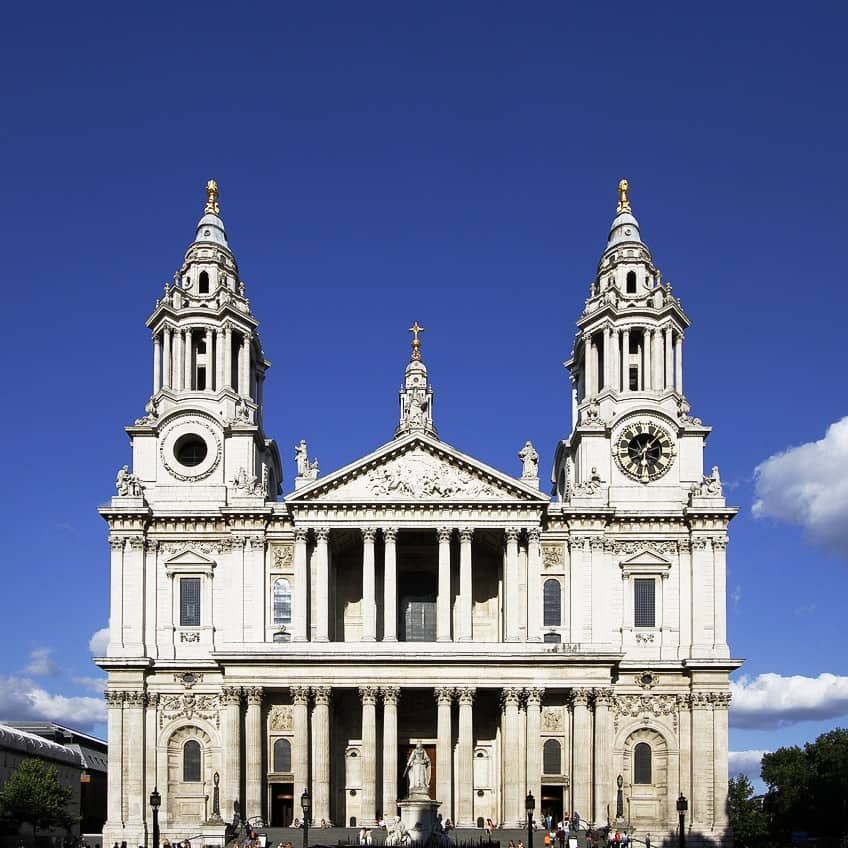
Ultimately, St Paul’s Cathedral in London has continued to exist despite any issues that come along and threaten the building. It is still a church, but also a tourist destination that makes a lot of money through its tours. However, they do at least allow worshippers to enter the structure for free. So, that’s good.
We have come to the end of our discussion about St Paul’s Cathedral in London. We have examined the architectural style of this building, the famous architect behind it all, the events that this building has seen over the course of its several centuries of existence, and some of its history. So, all that’s left to say is that we wish you a great day/week/month ahead!
Frequently Asked Questions
Where Is the St Paul’s Cathedral?
St Paul’s Cathedral is located on Ludgate Hill in London. This is a famous region around the hill in question. Furthermore, this indicates that this cathedral is quite central to the city in which it was constructed.
When Was the St Paul’s Cathedral Built?
There had been older churches in the location on which St Paul’s Cathedral in London was built. There have been religious settlements in the region as early as 60 CE, and one of those older churches burnt down in 1087 and was rebuilt by about 1240, but that structure also burnt down. So, just when was the St Paul’s Cathedral built then? Well, the current form was started in 1675 and finished construction in 1711. These may be the most accurate dates, as we typically refer to the present structure when asking questions such as this.
Which Architectural Style Does St Paul’s Cathedral Use?
The English Baroque style was used for the construction of St Paul’s Cathedral in London. This style is often quite ornate in its overall design, but the architect in charge used a more restrained form of Baroque architecture when designing this now immensely famous structure. English Baroque architecture is generally not significantly different from the rest of the continental Baroque style that developed throughout Europe, but it is quite different in this particular instance.
Who Was the Architect of St Paul’s Cathedral?
Christopher Wren was the architect behind St Paul’s Cathedral in London. This cathedral is only one of the many churches that Wren designed in the aftermath of the Great Fire of London in 1666. He has become known for far more than just his architecture though, and is a veritable English icon.
Why Was the St Paul’s Cathedral Rebuilt?
Fire tends to be somewhat bad for buildings. This is why when a fire tore its way through London in 1666, and became known as the Great Fire of London, it caused extensive damage to many buildings. The original St Paul’s Cathedral was not necessarily beyond repair, but a decision was made to simply wipe the slate clean and start over, and that decision led to one of the most famous cathedrals in the country, so it was probably the right decision to make.
Justin van Huyssteen is a writer, academic, and educator from Cape Town, South Africa. He holds a master’s degree in Theory of Literature. His primary focus in this field is the analysis of artistic objects through a number of theoretical lenses. His predominant theoretical areas of interest include narratology and critical theory in general, with a particular focus on animal studies. Other than academia, he is a novelist, game reviewer, and freelance writer. Justin’s preferred architectural movements include the more modern and postmodern types of architecture, such as Bauhaus, Art Nouveau, Art Deco, Brutalist, and Futurist varieties like sustainable architecture. Justin is working for artfilemagazine as an author and content writer since 2022. He is responsible for all blog posts about architecture.
Learn more about Justin van Huyssteen and about us.
Cite this Article
Justin, van Huyssteen, “St Paul’s Cathedral in London – The Historic London Cathedral.” artfilemagazine – Your Online Art Source. May 12, 2023. URL: https://artfilemagazine.com/st-pauls-cathedral-in-london/
van Huyssteen, J. (2023, 12 May). St Paul’s Cathedral in London – The Historic London Cathedral. artfilemagazine – Your Online Art Source. https://artfilemagazine.com/st-pauls-cathedral-in-london/
van Huyssteen, Justin. “St Paul’s Cathedral in London – The Historic London Cathedral.” artfilemagazine – Your Online Art Source, May 12, 2023. https://artfilemagazine.com/st-pauls-cathedral-in-london/.


